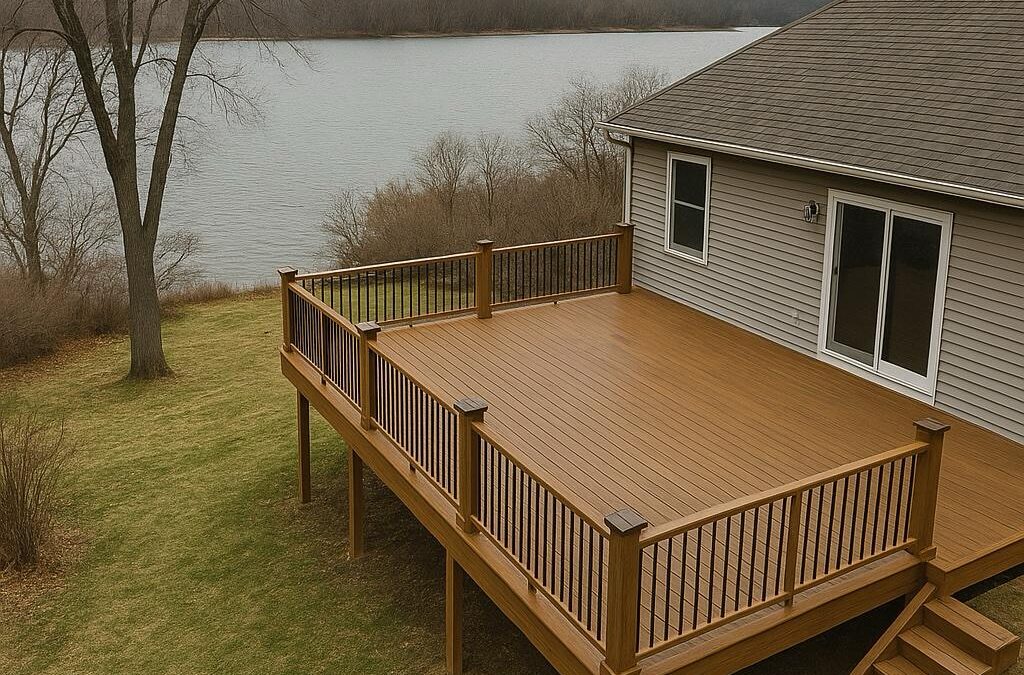Northwestern Illinois lake communities present unique construction challenges requiring careful navigation of multiple regulatory layers, specialized materials selection, and precise timing to succeed in this karst geology region with harsh freeze-thaw cycles.
Lake Carroll, Apple Canyon Lake, and The Galena Territory each require both county building permits and community architectural review approval, with construction costs ranging from $25-100 per square foot depending on materials and complexity. The optimal construction window is October through March, when contractors are available and ground conditions are most stable.
The Driftless Area geology creates distinctive challenges with fractured dolomite bedrock, potential sinkholes, and karst drainage patterns that demand specialized foundation work extending 42 inches below grade. Combined with severe weather patterns including temperatures from -38°F to 83°F and significant freeze-thaw cycles, successful projects require composite decking or properly maintained cedar materials.
Community approval processes add 30-120 days to project timelines, with specific setback requirements ranging from 7-30 feet and detailed architectural standards. Total project costs for typical 300-400 square foot lakefront decks range from $15,000-40,000, with labor representing 35-50% of costs in this rural region.
Building codes and regulatory framework
Jo Daviess County and Carroll County both require building permits for structures over 120 square feet, with fees ranging from $10-150 depending on size. Illinois DNR permits are required for any work below the ordinary high water mark, including dock construction and certain lakefront improvements. The joint permit application process serves multiple agencies but can take 60-120 days for review.
Structural requirements follow the International Residential Code with 40 pounds per square foot live load capacity and guardrails required for decks over 30 inches high. All footings must extend below the 42-inch frost line due to severe freeze-thaw conditions. The state’s recent adoption of the 2018 IRC as the minimum standard provides consistency across jurisdictions.
Dock construction typically requires individual DNR permits unless qualifying for limited Statewide Permit categories. Boathouse construction faces additional scrutiny regarding flood flow obstruction and seasonal water level accommodation. Property owners should budget $500-5,000 for permit fees depending on project complexity.
Key regulatory contacts include Jo Daviess County Planning & Development (815-591-3810) and the Illinois DNR Office of Water Resources (217-782-6302). Early coordination with both agencies prevents costly delays and redesign requirements.
Lake-specific construction challenges
The karst geology of the Driftless Area creates the most significant construction challenge, with underlying Galena Dolomite bedrock featuring solution-enlarged crevices 0.4 inches to 3 feet wide and potential cover-collapse sinkholes ranging 3-25 feet in diameter. This geology affects all three lake communities but manifests differently at each location.
Lake Carroll’s 640-acre controlled water system requires seasonal dock removal (October 31 to April 1) and ongoing sediment management programs. The $2.3 million Lake Improvement Program indicates active water level and quality management that affects construction timing and methods.
Apple Canyon Lake presents the steepest terrain challenges with 70-foot maximum depth, rocky limestone outcroppings, and 85% undeveloped greenspace requirements. The 15-mile shoreline’s steep inclines limit equipment access and require specialized foundation techniques for the fractured bedrock.
The Galena Territory’s 225-acre Lake Galena features controlled water levels with new marina facilities, but the community’s 6,800 acres of “rugged terrain” and designation as Community Wildlife Habitat creates additional environmental restrictions. The karst aquifer’s high contamination susceptibility requires careful construction practices to prevent groundwater impacts.
Common challenges include rapid water infiltration through karst features, extensive underground drainage systems, and potential subsurface voids from historic lead-zinc mining. Foundation work often requires rock-bearing designs and specialized geotechnical investigation for each site.
Materials and construction practices
Composite decking emerges as the top recommendation for Northwestern Illinois lakefront properties, with capped composite materials providing superior moisture resistance critical for freeze-thaw survival. Premium brands like Trex offer 25-50 year lifespans with minimal maintenance, justifying the $30-60 per square foot installed cost.
Western Red Cedar represents the best wood option, offering natural rot and insect resistance with excellent dimensional stability in extreme temperature swings. However, cedar requires regular sealing every 2-3 years and costs $35-55 per square foot installed.
Pressure-treated lumber remains the most economical choice at $25-50 per square foot, but the harsh climate and high humidity near lakes create maintenance challenges. Annual staining and 10-20 year replacement cycles make composite materials more cost-effective long-term.
Multi-level deck designs prove popular for the region’s sloping lakefront lots, though they increase costs to $60-100 per square foot. Under-deck drainage systems are essential for elevated decks, creating dry storage space while preventing moisture damage to structural components.
Local material suppliers include Spahn & Rose Lumber (Warren and Stockton) and Matrix Building Supply (Galena), though specialty composite materials may require sourcing from Dubuque area suppliers with $200-500 delivery fees.
Dock and boathouse regulations
Individual DNR permits are typically required for dock construction unless projects qualify for limited Statewide Permit #5 covering minor boat docks. The joint permit application serves IDNR, Army Corps of Engineers, and Illinois EPA simultaneously, with review times of 60-120 days depending on complexity.
Construction below ordinary high water mark requires DNR authorization regardless of size, and federal permits may apply depending on water body classification. Public notice requirements can extend review periods for larger or more controversial projects.
Boathouse construction faces stricter scrutiny due to potential flood flow obstruction and increased structural requirements. Designs must accommodate seasonal water level fluctuations and provide adequate anchoring for high water and ice conditions. Professional engineering consultation is typically required.
Application fees can reach $5,000 per project, making early consultation with DNR staff essential to determine permit requirements and avoid unnecessary costs. The Illinois Historic Preservation Division must also review projects in sensitive areas.
Seasonal and climate considerations
October through March represents the optimal construction window, offering contractor availability, lower costs, and stable ground conditions. Northwestern Illinois experiences harsh winters with temperatures reaching -38°F, but cold, dry conditions actually benefit pressure-treated lumber installation and concrete curing.
Severe freeze-thaw cycles remain the primary structural threat despite climate change reducing their frequency. The 42-inch frost depth requirement reflects historical extreme conditions that still occur periodically. Materials must withstand temperature swings up to 65°F in a single day.
Annual precipitation of 35 inches is increasing due to climate change, with projections showing 2-10% increases by century’s end. More intense storms and enhanced runoff create greater stormwater management needs for lakefront properties.
The region’s 71 days of annual snow coverage and frequent ice storms create significant structural loading that must be considered in design. Wind gusts up to 70 mph during severe weather require appropriate structural bracing and connection details.
Community-specific requirements
Lake Carroll’s Architectural and Environmental Committee requires approval for all improvements, with 25-foot front/side setbacks and 30-foot rear setbacks. The committee presents quarterly reports to the Board of Directors, though specific approval timeframes aren’t detailed. Plans must demonstrate Pierce County code compliance.
Apple Canyon Lake maintains the most detailed construction specifications, requiring 40 pounds per square foot deck loads and specific foundation requirements. Posts must anchor to concrete piers with galvanized metal anchors, and vegetation removal under decks is mandatory with landscape fabric and gravel coverage.
The Galena Territory operates the most complex approval system with four controlling documents and potential dual approval from satellite associations. All 3,270 lots automatically require architectural review, with some properties facing additional townhome or condominium association requirements.
Common requirements across all communities include mandatory pre-approval, detailed plans and specifications, site plans showing setbacks, and compliance with both community and county codes. Each community maintains enforcement authority including fines, construction stoppage, or required removal of non-compliant structures.
Cost analysis and budget planning
Total project costs for typical 300-400 square foot lakefront decks range from $15,000-40,000 depending on materials and complexity. Basic pressure-treated decks start around $8,000-15,000, while premium composite installations with features can reach $25,000-40,000.
Labor represents 35-50% of total project costs in rural Northwestern Illinois, with rates generally 10-20% lower than Chicago metro area but potentially offset by higher delivery costs for specialty materials. Seasonal construction timing can reduce labor costs by 10-15%.
Permit and approval fees typically total $500-2,000 including county building permits ($10-150), community architectural review fees (varies), and potential DNR permits ($500-5,000). Professional engineering consultation adds $100-220 per hour for complex designs.
Material delivery costs can be significant in this rural region, with full loads typically costing $200-500 from regional suppliers. Planning multiple deliveries or coordinating with other projects can reduce per-project costs.
Conclusion
Successful lakefront deck construction in Northwestern Illinois lake communities requires navigating complex regulatory requirements, understanding unique geological challenges, and selecting appropriate materials for harsh climate conditions. The karst geology demands specialized foundation techniques, while severe freeze-thaw cycles necessitate premium materials or intensive maintenance regimens.
The optimal approach combines October-March construction timing with composite decking materials, comprehensive drainage design, and early engagement with both county building departments and community architectural review committees. While initial costs may be higher than standard residential decks, proper planning and material selection ensure decades of lakefront enjoyment with minimal maintenance requirements.
Property owners should budget $20,000-35,000 for quality composite decks and allow 4-6 months for permitting and approval processes. Engaging local contractors experienced with karst geology and lakefront construction proves essential for successful project completion in this challenging but rewarding environment.


